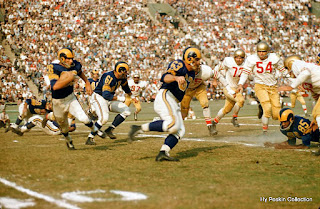The first Stars franchise was one of those vagabond franchises that just has a hard time finding a home. They were a charter member of the PCL as the Sacramento Salons in 1903, moved to Tacoma in 1904, returned to Sacramento in 1905, moved to Fresno in 1906. Left the PCL, came back in 1909 in Sacramento, then moved to San Francisco in 1914. The team was sold to a Utah businessman, who moved them to Salt Lake for the 1915 season.
Salt Lake was their first permanent home. They played as the Salt Lake Bees for eleven seasons, until their owner Bill Lane moved them to Los Angeles in 1926. They were the Hollywood Bees for a year, then renamed the Hollywood Stars.
Now, given my love of Hollywood, you'd think I'd be all over a team during Hollywood's Golden Age calling themselves the Hollywood Stars. However, the Stars never played anywhere near Hollywood, spending their entire existence as tenants in Wrigley Field. When the Angels doubled the Stars rent in 1935, the Stars left for San Diego, becoming the San Diego Padres.
Really, the only legacy of that first Stars franchise is the name. The Stars did manage to win two pennants in 1929 and 1930, but never caught on. Like the Los Angeles Angels major league franchise at Chavez Ravine, they were just something to watch when the real team was out of town.
The Padres, however, lasted 32 years in San Diego, and would eventually give their name to the new National League franchise.
The second Hollywood Stars began as the Vernon Tigers in 1909. Vernon was one of the few wet cities in LA county, and thus a great place for a baseball team. They too won two PCL pennants, but didn't really establish a rivalry with the Los Angeles Angels, especially after the first Hollywood Stars moved to Wrigley Field. The Tigers instantly picked up stakes and moved to San Francisco, but couldn't really establish a rivalry with the Seals either.
So the now Mission Reds moved back to LA in 1938, taking on the Hollywood Stars name. After one season, the Stars were sold to a local management group including Robert H. Cobb, of the Brown Derby restaurant and Cobb Salad fame.
These owners realized just slapping the Hollywood name wouldn't be enough, they needed to be a Hollywood team. So the Stars played one year in Wrigley Field then moved to Gilmore Stadium for a year as Gilmore Field on the same lot.
Gotta love the view of downtown, and that vintage neighborhood ballpark feel. Gilmore Field opened up in time for the 1939 season. The Stars won three pennants at Gilmore Field, and became heated rivals with the Los Angeles Angels. Gilmore Field could seat 13,000, was 335 to left and right, and 407 feet to dead center.
Not the most glamorous park from the outside, but it fits with Gilmore Stadium's functional style. The Hollywood Stars are responsible for some innovations, such as dragging the field in the fifth inning (making it, like the seventh inning stretch, a good time to hit the concession stands). They began televising home games in 1940, coincidentally, this whole Gilmore lot would eventually become CBS Television City.
That last note is actually more significant than I realized. When the Hollywood Stars broadcast their home opener on March 30, 1940 this as just the second baseball game ever broadcast and the first minor league game. It was broadcast by the Don Lee Broadcasting station W6XAO. Don Lee was a Cadillac dealer in Los Angeles, who partnered with Cal grad Harry Lubcke to start a VHF station.
By 1940, Don Lee had purchased RCA cameras from back east, and was broadcasting at 441 lines at 30 frames per second. Television was still a hobby at this point, there were only about 300 receivers in the area. Still, many celebrities turned out for the broadcast, including radio comedians George Burns and Gracie Allen ("Goodnight Gracie"). A shop window in Long Beach had a set tuned to the game, beginning a tradition that electronics stores would use to sell TVs as the fad caught on.
As for W6XAO, it was granted a commercial license as KTSL in 1948 (The second LA station behind KTLA). It's frequency was originally 1, but chanced to 2 when the FCC decided to reserve 1 for low wattage community TV. CBS and the LA Times were the owners of KTTV 11 (49% CBS, 51% LA Times). The Times refused to sell their majority share, so CBS bought KTSL and changed it to KNXT to match their LA radio station.
Those who grew up in Los Angeles probably remember KNTX, as channel 2 kept that call-sign until 1984 when it was rebranded KCBS.
So the station that would become CBS, broadcasts a baseball game from Gilmore Field, then two years later it's razing the lot to create CBS Television city, the main branch of CBS's television operations. And just to show the Stars weren't the only ones on board with this television thing, here's the LA Angels in the Don Lee studio, filming an experimental broadcast in 1939.
I never really know where these entries are going to go. I learned so much researching this.




































